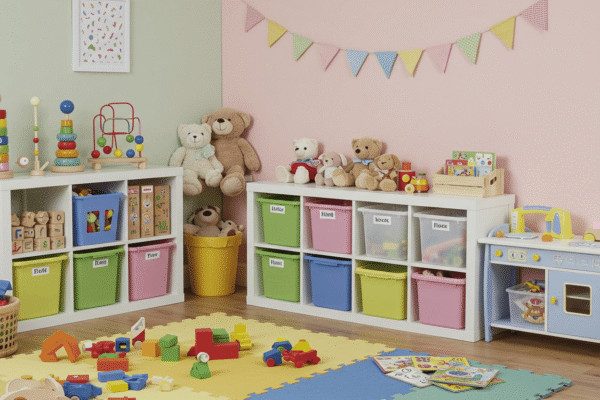Seasonal clothing storage is more than just packing away your winter coat or summer dresses—it’s a smart way to protect your wardrobe, save space, and simplify your daily routine. Whether you live in a cozy apartment or a spacious house, mastering seasonal clothing storage helps keep your clothes fresh, organized, and easy to access when the seasons change. In this guide, you’ll discover clever tips and practical ideas to make storing your off-season clothes effortless and efficient, so you can enjoy a clutter-free closet all year round.
Why Seasonal Clothing Storage Matters
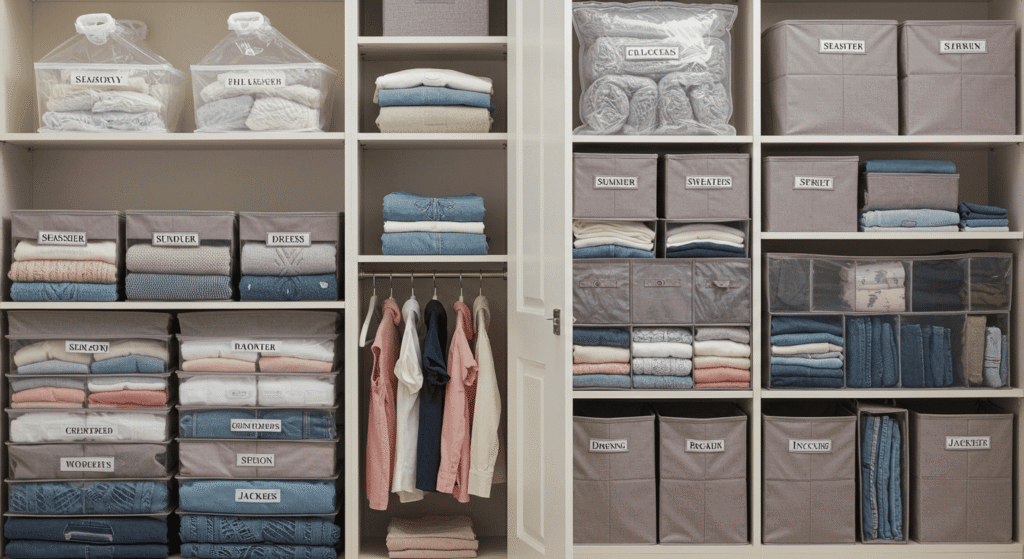
Proper seasonal clothing storage plays a crucial role in maintaining the condition of your wardrobe and maximizing your living space. When clothes are not stored correctly during their off-season, they are exposed to risks that can cause damage, shorten their lifespan, and make your closet messy and difficult to manage. Understanding why seasonal clothing storage matters helps you appreciate the value of investing time and effort into organizing your clothes thoughtfully.
The Impact of Poor Storage on Your Clothes
Failing to store your seasonal clothes properly can lead to irreversible damage. Clothes that are carelessly packed or left in unsuitable environments often suffer from a range of problems that reduce their quality and appearance.
Common Damage Causes (moths, dust, wrinkles, odors)
- Moths and pests: Natural fibers like wool and cashmere attract moths, which can create holes in garments if not properly protected.
- Dust accumulation: Clothes stored in open or loosely covered areas tend to gather dust, leading to discoloration and dirt buildup.
- Wrinkles and creases: Improper folding or overcrowding causes clothes to develop stubborn wrinkles that can be difficult to remove.
- Unpleasant odors: Clothes stored in damp or poorly ventilated spaces can absorb musty smells or mildew, making them unpleasant to wear.
Benefits of Smart Seasonal Storage
Investing in an efficient seasonal clothing storage system comes with several benefits that go beyond just protecting your clothes. It improves your overall home organization and simplifies your daily life.
Save Space, Protect Clothes, Simplify Daily Dressing
- Save space: By storing off-season clothes thoughtfully, you free up valuable closet room, allowing your current-season wardrobe to be more accessible.
- Protect clothes: Using the right storage techniques and materials keeps fabrics safe from damage, pests, and environmental factors.
- Simplify daily dressing: When your clothes are well-organized and rotated seasonally, finding the right outfit becomes easier, saving you time and stress.
Visual idea:
| Before Smart Storage | After Smart Storage |
|---|---|
| Overcrowded closet with clothes piled | Neatly organized seasonal sections |
| Clothes wrinkled and dusty | Clothes folded or hung properly, dust-free |
| Limited space for current season items | Extra space for easy access to daily wear |
| Risk of moth and pest damage | Clothes protected in breathable storage bins |
Planning Your Seasonal Clothing Storage System

A successful seasonal clothing storage system starts with careful planning. Understanding the scope of your wardrobe and the space you have available is essential to create a storage solution that fits your home and lifestyle. Taking time to assess these factors helps you avoid clutter and keeps your clothes protected throughout the year.
Assessing Your Wardrobe and Space
Before choosing storage methods, you need to evaluate what you own and where you will store it. This assessment lays the foundation for an organized and efficient system.
How to categorize clothes by season
Divide your wardrobe into clear categories based on the seasons: spring, summer, fall, and winter. Consider the climate where you live, as some seasons may overlap or be shorter. Group items like heavy coats, sweaters, and boots for winter, while lighter fabrics, shorts, and sandals belong to the summer category. This separation simplifies rotation and ensures you store only what’s necessary for the off-season.
Measuring your storage space efficiently
Next, measure the available storage areas you plan to use, such as closets, under-bed spaces, or storage rooms. Accurate measurements help determine the size and number of storage containers or organizers you’ll need. Consider the height, width, and depth of shelves or boxes, and remember to account for accessibility so you can retrieve items easily when needed.
Choosing the Right Storage Method for Your Home
Once you know what you have and where you can store it, select storage methods that suit your space and routine. Different homes and lifestyles require tailored solutions for effective seasonal clothing storage.
Closet rotation vs off-site storage options
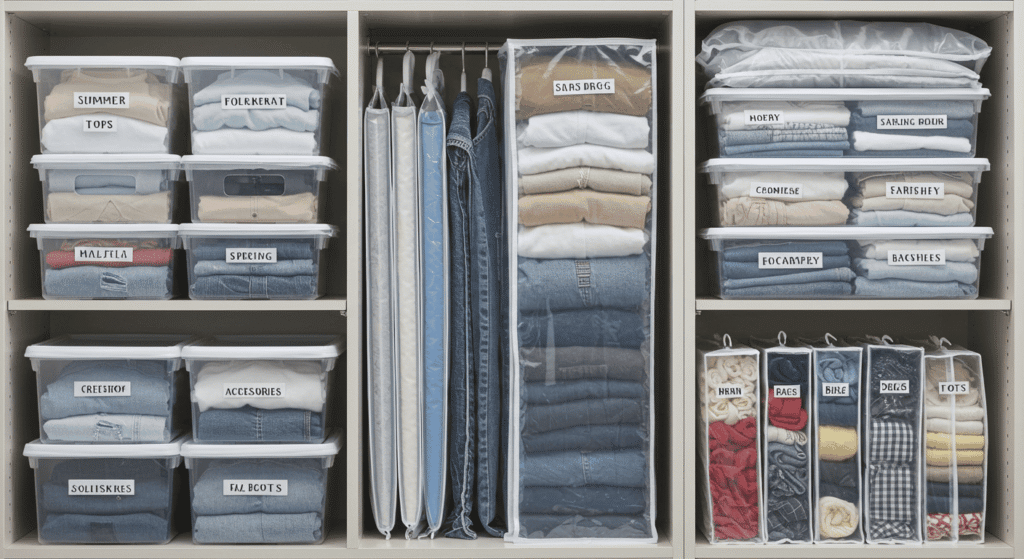
Closet rotation involves swapping out seasonal clothes within your main wardrobe space, keeping only current-season items easily accessible. This method works well if your closet space is sufficient and you prefer to keep everything at home. Alternatively, off-site storage or dedicated storage spaces within your home can be used for larger volumes of clothing or special items you don’t use often, freeing up your main closet for daily wear.
Small-space solutions vs larger home setups
For small homes or apartments, compact storage solutions like vacuum bags, under-bed boxes, or multi-functional furniture help maximize space without sacrificing protection. Larger homes often have the luxury of dedicated storage rooms, large closets, or attics, allowing for bulk storage options such as shelving units and garment racks, which can be customized according to the volume and type of clothing.
| Wardrobe Assessment Checklist | Space Measurement Checklist |
|---|---|
| Categorize clothes by season | Measure height, width, and depth of storage areas |
| Identify delicate or special fabrics | Note accessibility and ventilation |
| Count bulky vs lightweight items | Plan for container sizes and quantities |
| Decide which clothes need frequent access | Consider space for seasonal rotation |
Best Techniques for Storing Seasonal Clothes
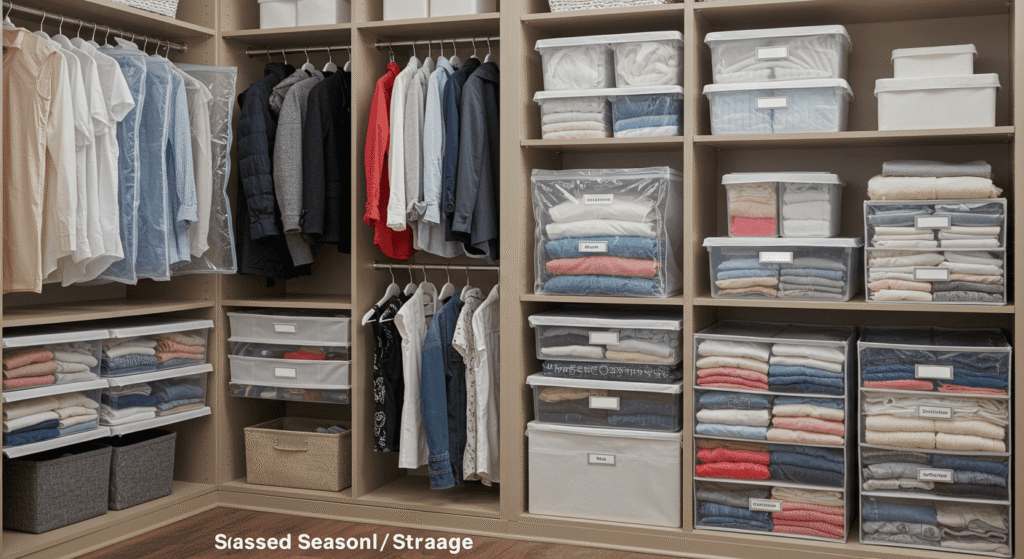
Choosing the right storage techniques is key to maintaining your clothes’ condition during the off-season. Different fabrics and garment types require different methods, and understanding the benefits of each technique helps you create an effective seasonal clothing storage system that keeps your wardrobe fresh and ready to wear.
Folding vs Hanging: What Works Best?
Deciding whether to fold or hang your seasonal clothes depends largely on the type of garment and available storage space. Heavy sweaters and delicate knits are better folded to prevent stretching, while dresses, coats, and blouses often maintain their shape better when hung. Proper folding techniques can also save space and reduce wrinkles, but overcrowding hangers can cause creasing and misshaping.
Using Breathable vs Airtight Storage Containers
Selecting the right container type is essential to protect clothes from moisture, dust, and pests during storage. Both breathable and airtight containers have their uses depending on the material of your clothes and your storage environment.
Pros and cons of each container type
- Breathable containers: These allow air circulation, preventing moisture buildup that can cause mold and mildew. They are ideal for natural fabrics like wool and cotton but may not protect as well against dust and pests.
- Airtight containers: These provide a sealed environment that keeps out moisture, insects, and dust, making them suitable for delicate or valuable items. However, without proper drying of clothes before storage, airtight containers may trap humidity and cause damage.
Vacuum Storage Bags: When and How to Use Them
Vacuum storage bags are a popular choice for compressing bulky items like winter coats and blankets, saving significant space. They work by removing air to create a tight seal, which helps reduce volume and protect against pests. However, they are best used for synthetic fabrics or items that can tolerate compression. Natural fibers like wool or silk should generally be stored using more breathable methods to maintain their shape and texture.
| Storage Technique | Pros | Cons |
|---|---|---|
| Folded Clothes | Saves space, prevents hanger stretching | Can create wrinkles if not folded properly |
| Hanging Clothes | Maintains shape, easy access | Requires more space, risk of hanger marks |
| Breathable Containers | Prevents mold, allows airflow | Less protection against dust and pests |
| Airtight Containers | Seals out moisture, dust, and pests | Risk of trapped humidity if clothes aren’t dry |
| Vacuum Storage Bags | Compresses bulky items, protects from pests | Not ideal for delicate fabrics, can crush fibers |
Protecting Your Clothes During Storage
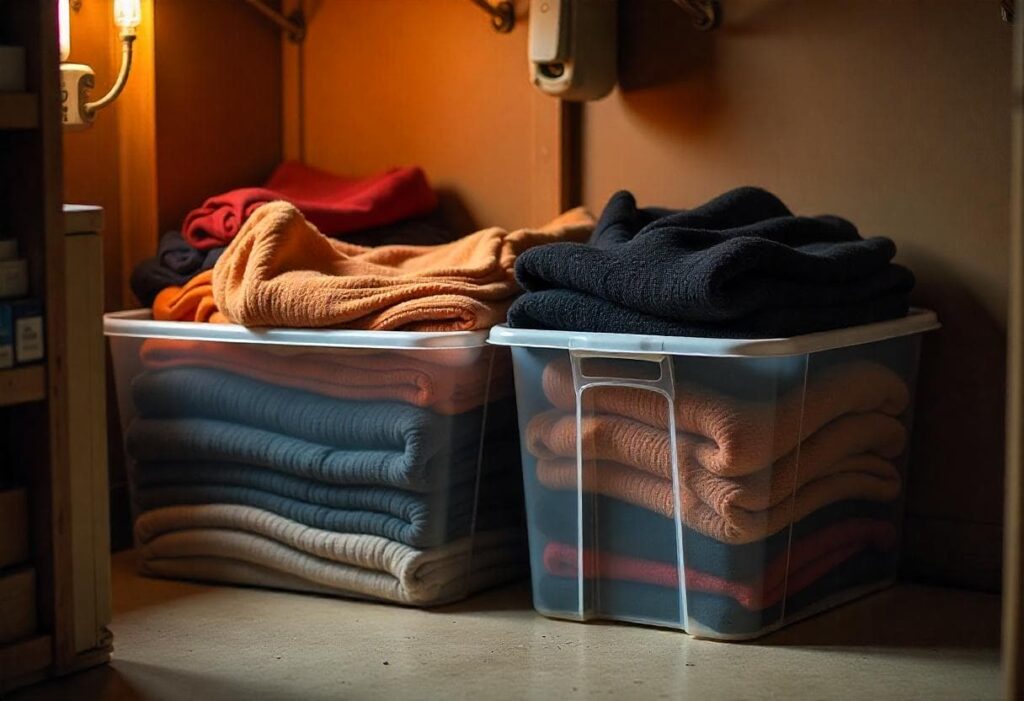
Proper seasonal clothing storage isn’t just about putting your clothes away—it’s about protecting them from damage so they look and feel great when you bring them back out. Taking the right precautions can save your wardrobe from pests, moisture, odors, and wrinkles, keeping everything fresh and ready to wear.
Preventing Moth and Pest Damage
Moths and other pests can cause significant damage to your stored clothes, especially those made from natural fibers like wool, cashmere, and silk. To prevent infestations, store clothes in sealed, breathable containers and avoid leaving dirty or worn items inside, as food stains and body oils attract pests. Including natural repellents such as lavender sachets or cedar blocks can also deter moths without harsh chemicals. Regularly inspecting stored clothes and airing them out periodically helps catch any issues early.
Controlling Moisture and Odors
Moisture is one of the biggest threats to clothes in storage, as it promotes mold, mildew, and unpleasant odors. Store clothes only when they are completely dry and choose storage spaces that are cool, dry, and well-ventilated. Using moisture absorbers like silica gel packets or baking soda in storage containers can help keep humidity at bay. For odors, avoid plastic bags that trap smells and opt for breathable storage solutions or add natural deodorizing elements like charcoal bags.
Keeping Clothes Fresh and Wrinkle-Free
To keep your clothes fresh, avoid overpacking storage containers, as overcrowding leads to wrinkles and creases. Use acid-free tissue paper to separate delicate garments and maintain their shape. Hanging clothes on padded hangers, when possible, also helps prevent wrinkles. When it’s time to retrieve your seasonal clothes, allow them to air out before wearing or storing again to refresh the fabrics.
Organizing Your Seasonal Wardrobe for Easy Access
An effective seasonal clothing storage system isn’t just about packing away clothes—it’s also about making sure you can find what you need quickly and easily when the season changes. Smart organization keeps your wardrobe accessible and stress-free, turning seasonal rotation into a simple, enjoyable task.
How to Rotate Clothes Seasonally Without Stress
Seasonal rotation can feel overwhelming if you don’t have a plan. Start by scheduling regular wardrobe switches, such as at the start of each season or when the weather noticeably changes. Remove all out-of-season clothes, inspect them for damage or stains, and clean items if needed before storing. Bring out the new season’s clothes in an organized way, keeping frequently worn pieces front and center for easy access. Establishing this routine minimizes clutter and keeps your closet functional year-round.
Labeling and Categorizing for Quick Finds
Labels are your best friend when it comes to seasonal clothing storage. Use clear, descriptive labels on storage bins, boxes, or shelves to quickly identify contents without unpacking everything. Categorize clothes by type—such as sweaters, jackets, or accessories—and by season, so you can grab exactly what you need in seconds. Consider using tags or color-coded stickers to enhance clarity and speed up your search.
Using Storage Zones or Color Coding
Creating dedicated storage zones within your closet or storage area streamlines your seasonal rotation. Allocate specific sections for each season or clothing category, ensuring everything has a “home.” Color coding your storage containers, labels, or hangers adds a visual layer of organization that makes it even easier to find items quickly. For example, use blue tags for winter wear, yellow for summer, and green for spring/fall. This method reduces decision fatigue and keeps your wardrobe orderly.
Space-Saving Hacks for Seasonal Clothing Storage
Maximizing space is a common challenge when it comes to seasonal clothing storage. Clever use of every nook and cranny, combined with smart storage solutions, can make a big difference—especially if you live in a small apartment or simply want to keep your home tidy and clutter-free.
Utilizing Under-bed and Overhead Storage
Under-bed storage is an often-overlooked area perfect for stashing off-season clothes. Slim, low-profile containers or rolling bins fit neatly beneath your bed and keep clothes protected yet accessible. Overhead storage, such as shelves near the ceiling or atop closets, can house less frequently used seasonal items safely out of the way. Just make sure to use sturdy containers with secure lids to avoid dust and damage.
Multi-purpose Furniture and Storage Solutions
Furniture that doubles as storage is a game-changer for space-saving. Ottomans with internal compartments, storage benches, and beds with built-in drawers allow you to store clothes discreetly while also serving everyday functions. These multi-purpose pieces free up closet space and keep your living areas neat, blending storage seamlessly into your home décor.
Creative DIY Storage Ideas to Maximize Space
DIY solutions add a personal touch while solving storage problems creatively. For example, repurposed wooden crates stacked and secured can create custom shelving. Hanging shoe organizers aren’t just for shoes—they’re great for small accessories or folded items like scarves and gloves. Using tension rods inside closets to hang multiple layers of clothing or bags can also boost storage capacity without major renovations.
Seasonal Clothing Storage Tips for Different Types of Fabrics
Understanding how to store different fabrics properly is crucial for effective seasonal clothing storage. Each fabric type has unique needs that, when addressed, help preserve the look, feel, and lifespan of your garments.
Handling Delicate Fabrics (silk, wool, cashmere)
Delicate fabrics like silk, wool, and cashmere require extra care. Always clean these items before storing to remove oils and dirt that attract pests. Use breathable garment bags or cotton storage bags to allow airflow and prevent moisture buildup. Avoid hanging heavy wool or cashmere pieces as this can stretch the fibers—fold them gently with acid-free tissue paper to maintain shape. Cedar blocks or lavender sachets can help keep pests away naturally.
Storing Heavy Fabrics (denim, leather, coats)
Heavy fabrics such as denim, leather, and coats benefit from sturdy hanging storage to maintain their shape. Use strong, wide hangers to support the weight without causing shoulder bumps. For leather, avoid plastic bags which can trap moisture—opt instead for breathable covers to prevent cracking. Denim can be folded or hung depending on available space, but ensure it’s clean and dry to prevent mildew during storage.
Caring for Everyday Fabrics (cotton, polyester)
Everyday fabrics like cotton and polyester are more durable but still need proper storage to avoid wrinkles and odors. These fabrics can be folded or hung, depending on your storage system. Store cotton garments in breathable bins or drawers to allow air circulation, while polyester, which is less prone to mildew, can be stored in airtight containers if space is tight. Washing clothes before storage is essential to avoid stains setting permanently.
| Fabric Type | Best Storage Method | Key Care Tips |
|---|---|---|
| Silk, Wool, Cashmere | Folded with acid-free tissue; breathable garment bags | Clean before storage; avoid hanging heavy items; use natural repellents |
| Denim, Leather, Coats | Hang on sturdy hangers; breathable covers for leather | Avoid plastic for leather; keep dry; clean before storing |
| Cotton, Polyester | Fold or hang; breathable bins for cotton; airtight for polyester | Wash before storage; avoid overcrowding; allow airflow where possible |
Maintaining Your Seasonal Storage Setup Year-Round
Keeping your seasonal clothing storage system effective requires ongoing care and adjustments throughout the year. Regular maintenance not only protects your clothes but also ensures that your storage system stays organized and suited to your evolving needs.
Regular Checkups and Refreshing Your Storage
Routine inspections are essential to catch any issues early, such as pest activity, moisture buildup, or wrinkles. Schedule regular checkups—ideally every few months—to air out stored clothes, replace natural repellents, and reorganize any displaced items. Refreshing your storage containers by cleaning or swapping them out helps maintain a clean environment and prolongs the life of your wardrobe.
How to Prepare Clothes for Storage and Reuse
Before storing clothes, make sure they are thoroughly cleaned and completely dry to prevent stains, odors, and mold. Repair any damages like loose buttons or small tears to avoid worsening while in storage. When retrieving clothes for reuse, take time to air them out and steam or iron to remove wrinkles and freshen fabrics. This preparation ensures your clothes stay in excellent condition season after season.
Adjusting Your System Based on Lifestyle Changes
Your storage needs can shift due to changes in lifestyle—new hobbies, climate shifts, family additions, or evolving fashion preferences. Periodically reassess your system to accommodate these changes. For example, if you start a new outdoor activity, you might need more space for seasonal gear. Flexibility and adaptability in your storage setup keep it efficient and relevant, making your seasonal wardrobe management hassle-free.
Mastering Seasonal Clothing Storage: Your Key to a Clutter-Free, Protected Wardrobe
Mastering seasonal clothing storage is more than just putting away your clothes—it’s about protecting your wardrobe, saving space, and simplifying your daily routine. By planning thoughtfully, using the right techniques, and maintaining your system year-round, you ensure your clothes stay fresh, wrinkle-free, and ready to wear whenever the season changes. With these smart tips, your seasonal storage will become an effortless, organized part of your home, giving you more time and peace of mind to enjoy your favorite outfits all year long.








